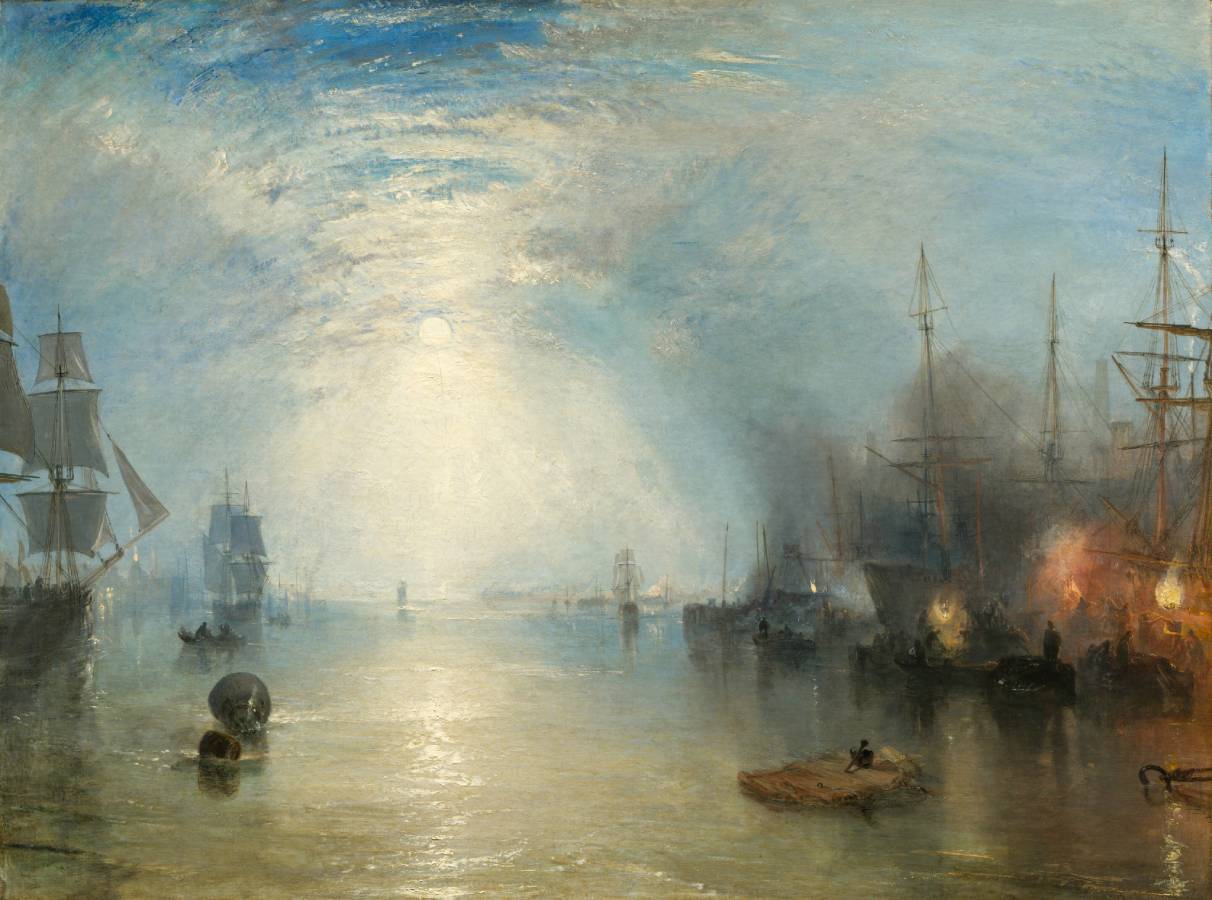Turner, Joseph Mallord William (1775-1851)
Keelmen Heaving in Coals by Moonlight
1835
Oil on canvas, 92.3 x 122.8 cm
National Gallery of Art, Washington
Joseph Mallord William Turner excelled at capturing the beauty and mysteries of light. Cool, white moonlight contrasts with warm, yellow and orange firelight. Shimmering reflections animate the water’s still surface. The setting is the port of Newcastle, England, where coal from inland mines is being loaded onto ships. Coal was used to fuel the factories, mills, railroads, steamships, and other great machines that were transforming Britain during the Industrial Revolution. The dark smoke rising on the right may refer to the increasing air pollution. Here Turner brings the great force of his romantic genius to a common scene of working–class men at hard labor. Although the subject of the painting is rooted in the grim realities of the industrial revolution, in Turner‘s hands it transcends the specifics of time and place and becomes an image of startling visual poetry. An almost palpable flood of moonlight breaks through the clouds in a great vault that spans the banks of the channel and illuminates the sky and the water. The heavy impasto of the moon’s reflection on the unbroken expanse of water rivals the radiance of the sky, where gradations of light create a powerful, swirling vortex. To the right, the keelmen and the dark, flat–bottomed keels that carried the coal from Northumberland and Durham down the River Tyne are silhouetted against the orange and white flames from the torches, as the coal is transferred to the sailing ships. To the left, square riggers wait to sail out on the morning tide. Behind these ships Turner suggested the distant cluster of factories and ships with touches of gray paint and a few thin lines. Through the shadowy atmosphere ships’ riggings, keels and keelmen, fiery torches, and reflections on the water merge into a richly textured surface pattern. We hover over a flax-yellow body of water lined with ships to our left and right, which are silhouetted against a moonlit, cloud-veiled sky in this horizontal landscape painting. The horizon comes about a third of the way up the composition. The moon hangs to our left of center in the sky, its light reflecting on the clouds in a bright, hourglass shape to create a tunnel-like effect. The sea below turns from a gold color close to us to pale blue along the horizon. To our left, one ship with gray sails is cut off by the edge of the canvas and another, also with gray sails, is situated farther from us. A small, dark rowboat with two passengers moves between them. Light from the windows in buildings along the distant horizon to our left reflect in the water, and another building, a factory, spouts white flame from its chimney. More dark ships line the waterway to our right, their spiky masts black against the sky. Three flames, one orange between two pale yellow fires, flare in the darkness in front of the ship closest to us. The forms of men shoveling coal, crates, and barges are dark silhouettes against the firelight and smoke. More rowboats float among the boats in the distance. Near the lower right corner of the canvas, a broad, flat fragment of wood floats close to us. The hot orange and black on the right side of the painting contrasts with the silvery gray, light blue, and white that fills much of the rest of the composition. The painting was created with thick, blended brushstrokes throughout, giving the scene a hazy look. The texture of some of the brushstrokes is especially noticeable, as where the moon casts white light onto the water and in the clouds. The artist signed a buoy floating to our left with his initials, “JMWT.” (NGA)
